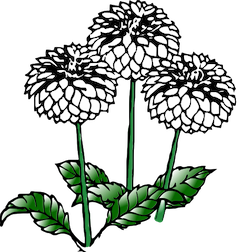 | dahlia society of victoria | LOGIN: |
Dahlias take well to an organic approach to gardening. Pest control can often be accomplished using simple protective measures without resorting to chemicals that have undesirable side-effects. If you are growing dahlias intensively and want perfect blooms for showing you must be prepared to deal with a variety of pests and diseases. Growers who have many plants close together often use a fortnightly spraying program – firstly with a combined insecticide/miticide. As the plants start growing strongly, they can add fertiliser to the mix.But if you don’t like the idea of routinely using chemical control, jump on problems when they arise and treat appropriately. The website of Sustainable Gardening Australia lists most of the garden pests that can afflict dahlias, with eco-friendly practices and products that avoid impacting beneficial insects and the environment generally. If you do use pesticides, using them in rotation will reduce the risk of introducing resistance. Snails and SlugsGastropods love new dahlia shoots. Unless you intervene they will be nipped off. Although the plant will grow new shoots it will suffer and will flower later, probably too late for the early dahlia shows. The easiest protection is to spread snail pellets around your plants. Alternatively use obstacle barriers like crushed eggshells, wood ash, sawdust or a mulch of strong smelling herbs (eg wormwood or tansy). Beer traps result in fast, fatal alcoholic poisoning (no, they just drown and some non-alcoholic alternatives work well). Other traps are effective but must be checked every day and the contents disposed of. RabbitsIf you live in the country these are likely to devour all the new growth. Plants must be protected with cages until the plants are too large for the rabbits to bother them. You can also contain the whole patch in a rabbit-proof fence with wire mesh that runs along its foot and extends down or out in the ground. The gate also needs a barrier under it. EarwigsThe chewing of earwigs can do a lot of damage to buds and flowers. Trapping is the best solution, and an eco-friendly one. There are many kinds of traps but perhaps the simplest is scrunched up damp newspaper in small flower pots near the dahlias or on the stakes. After feeding at night, earwigs crawl into the pots to hide so you can find them in daylight and dispose of them. InsectsAphids, whitefly, thrips, mealybugs and other sap-suckers in small numbers will not normally affect a dahlia plant severely but populations can explode to the point they must be dealt with. Sap-suckers can also be vectors for virus, spreading it from plant to plant through the patch. Other leaf, flower and root chewing insects such as caterpillars, various beetles, leaf hoppers and other bugs do not normally do much damage to dahlias but may transmit disease and may need treatment if their numbers increase. There are different approaches you can take to deal with these many kinds of insects. Ideally get advice to identify a solution to your particular pest that has minimal impact on the environment. Hosing off, picking off and even shaking the plants to disturb the critters works if you don’t have too many plants. Commercial organic sprays or home-made ones using soap, garlic, chilli or botanical oils are effective and generally kind to non-pests. Some insecticides are fairly specific in their action. Others – yellow sticky traps for example – are not and will affect beneficial insects. Insects that spend part of their life-cycle in the soil can be controlled by drenching the soil with a suitable grub killer. Natural predators can be encouraged by planting companion plants like alyssum, marigolds, yarrow and dill. There are also products that attract predatory insects. Some predators, including lady beetles, lacewings, and certain wasps, can be purchased for release in your garden. MitesMites, particularly Red Spider (aka Two Spot mite), suck plant sap, mainly on the under surface of leaves, especially during hot, dry weather. The mites can be almost invisible but can usually be identified by the webs they produce when the infestation grows to the point that leaf damage is visible. They can be removed by watering the underside of the leaves or spraying with a miticide (not an insecticide which will only kill the good guys). There is also a predatory mite available for purchase. MILDEWHumidity and poor air circulation encourage both downy mildew and powdery mildew. All mildews can be treated the same way. Improve air circulation by removing some lower leaves and avoid watering the leaves late in the day. Removing affected leaves slows the spread – these must be burned or binned, not composted. Commercial fungicides are effective. An alternative is a 1:6 mixture of full-cream milk and water sprayed on the leaves. VirusesIt is almost certain that a patch of any size contains some plants infected with one of the six or more viruses identified so far that affect dahlias. The most common sign of virus infection is yellowing of the leaf veins, sometimes accompanied by distortion and stunting of the leaves and stems. When you work on your plants or divide tuber clumps you risk moving a virus from infected plants to clean plants unless you disinfect your tools between each plant. The cheapest and simplest method is to dip the tools in a 10% solution of household bleach in water. An aggressive “if in doubt, throw it out” approach will significantly reduce the incidence of virus over time. Removed plants must be burned or sent to landfill, not composted. At the end of the season dig and save only the strongest and healthiest plants. You should still have plenty of tubers for next year and you eliminate the risk of a weaker plant’s condition being a sign of an as yet unapparent virus infection. Controlling populations of insects, especially thrips, that are known transmitters of diseases between plants will help contain the virus problem. |